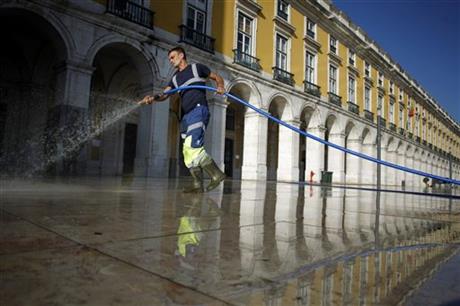
By PAN PYLAS
Lisbon municipal street cleaner Carlos Rodrigues pulls a hose as he works at Comercio square in downtown Lisbon, Tuesday, Nov. 12, 2013. Rodrigues, who earns the minimum salary in Portugal, which is euro 485 ($648.9), said that his income went down by around 40 percent after salary cuts and the reduction in the amount of overtime pay since 2012. Many workers, especially those on the public payroll, have endured two years of falling income and higher taxes since Portugal’s euro 78 billion ($105 billion) bailout in 2011. More austerity is planned next year as Portugal’s creditors and other countries using the euro currency compel Lisbon to get its finances into shape. (AP Photo/Francisco Seco)
LONDON (AP) — Three months after it emerged from recession, the 17-country eurozone economy is scarcely growing.
The currency union’s economy expanded just 0.1 percent in the July-September quarter compared with the previous three-month period, the EU statistics agency, Eurostat, said Thursday. That was in line with market expectations but below the previous quarter’s 0.3 percent increase.
The figure highlights the bloc’s struggles to regain economic health despite signs of life in the rest of the global economy, notably in the United States. European government debt, despite years of government cutbacks and tax increases, remains high, unemployment is at a record, and consumers are hesitant to spend.
As a result, few economists think the recovery in the eurozone can pick up a head of steam and become self-sustaining in the way it has in the U.S. In the third quarter, the U.S. grew at an annualized rate of 2.8 percent, compared with the eurozone’s annualized rate of about 0.4 percent.
“The drop in the eurozone growth rate does not mean that the eurozone is heading back into recession but it highlights that the recovery is fragile and, as yet, too slow to lead to a significant fall in unemployment,” said Marie Diron, senior economic adviser to EY, formerly known as Ernst & Young.
The weak economic backdrop is one reason why the European Central Bank cut its main interest rate last week to a record-low 0.25 percent. The other being low inflation. In the year to October, consumer prices were up only 0.7 percent, way down on the ECB’s mandate of keeping inflation just below 2 percent.
Though details were not provided for individual sectors, Thursday’s figures show the recovery slowed in the core economies, such as Germany and France, with mild improvements in countries in the so-called periphery, notably in Spain, which saw its nearly two-year recession end.
Germany’s economic growth slowed to a quarterly rate of 0.3 percent from 0.7 percent in the previous three-month period as exports dragged. For an economy that relies heavily on its high-value exporters, such as big car manufacturers like BMW and Daimler, that’s a sign of weak demand among its neighbors and possibly an indication that the recent high value of the euro has taken its toll.
In France, the situation was even more downbeat, with Europe’s second-largest economy posting a quarterly contraction of 0.1 percent. It’s not in recession, though, as it grew by 0.5 percent in the previous quarter — a recession is traditionally defined as two consecutive quarters of negative economic growth.
Looking ahead, most economists predict the eurozone will continue to grow, albeit at a sub-par rate. Many of the factors that have hobbled growth, notably the easing in the tensions in the financial markets, will help shore up economies.
“The region is on course to expand at a slightly stronger, though still modest, pace in the fourth quarter,” said Chris Williamson, chief economist at financial information company Markit.



